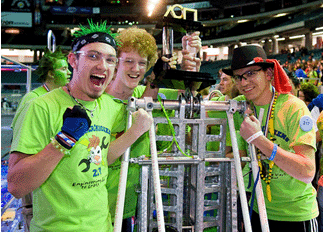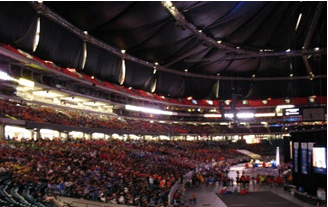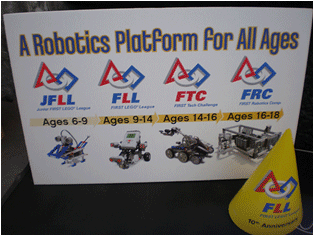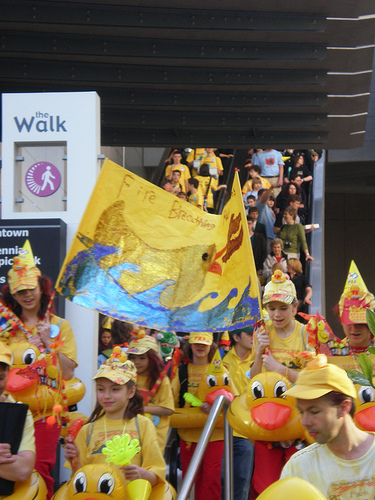Making Team Innovation Work
Learning from FIRST How to Inspire Inventors and Build an Innovative Culture
At FIRST’s annual world robotics championship, Patty and her Visionaries witnessed first hand how kids can work together while competing, coming up with innovative solutions to difficult challenges. The process by which these challenges are set up and executed provides important lessons on how to inspire innovation.
One of Three Winning FRC Teams!

Photo by Akill11, Flickr
Illustration 1. Three members of the ThunderChickens: one of the three championship teams. The Winning Alliance of the FIRST Robotics Competition Championship was: Team 148 “Robowranglers” of Greenville High School from Greenville, Texas; Team 217 “ThunderChickens” of Utica Community Schools from Sterling Heights, Michigan; Team 1114 “Simbotics” of Governor Simcoe Secondary School from St. Catharines, Ontario, Canada.
HOW TO FOSTER INNOVATION AND GRACIOUS PROFESSIONALISM
How do you build a culture that nurtures repeated success in innovation?
1. Give a really hard problem to solve to multiple teams of smart, motivated people.
2. Give them unrealistic deadlines, too little money, and not enough resources, so they have to become inventive in creating their own conditions for success.
3. Give them, as a reward, the opportunity to compete against and to learn from other teams who are working on the same problem.
4. Provide each team with many opportunities to test and refine their solution in real world conditions in competition with others who are solving the same problems.
5. Provide each team with mentors—knowledgeable experts who don’t have the answers but who are willing to learn and explore with each team.
6. Celebrate all aspects of success, including teamwork, learning, community service, mentoring, marketing, and entrepreneurialism.
7. Provide a framework for them to do this over and over again, year after year, and to spawn and mentor new teams.
That’s what FIRST has done with kids. Can we do it with our own employees? As Woodie Flowers reminds us (see below), “Societies get the best of what they celebrate!”
We held our Spring Visionaries’ [1] meeting in conjunction with FIRST ’s annual world robotics championship in Atlanta, Georgia. FIRST , which stands “For Inspiration and Recognition in Science and Technology, is a not-for-profit organization founded by Dean Kamen in 1989 to inspire kids to excel in science and mathematics. FIRST ’s selection of the Georgia Dome sports arena as the venue for its world championships is not accidental; Dean Kamen’s vision is that smart kids who excel in math, science, engineering, and computer science should be celebrated in the same ways that we celebrate athletes or rock stars. So these competitions—both the regional play-offs and the world championships—take place in sports arenas, complete with cheerleaders, referees in uniforms, professional announcers, and video coverage—filmed and broadcast over the NASA channel.
Each year, there’s a set of regional robotics competitions that culminate in this annual world championship. This year, close to 125,000 kids from 38 countries participated in these regional robotics challenges. Several thousand kids from the winning teams competed in the World Robotics Championships.
The Audience for the 2008 FIRST Championship in the Georgia Dome

Photo by Dominique, Flickr
Illustration 2. The audience waits in anticipation for the opening ceremonies of the FIRST Robotics Championship at the Georgia Dome in Atlanta on April 18, 2008.
There are different leagues for different age groups (see Illustration 3).
- FRC. Young people from 16 to 18 compete in the FIRST Robotics Competition—the “Varsity Sport for the Mind.” This year, there were 15,000 young people in 1500 teams from all 50 U.S. states and 8 countries (including Brazil and Israel). They competed in 41 regional events around the world to qualify for the world championships.
- FTC. Junior High school kids from 14 to 16 compete in the FIRST Tech Challenge. This year 8,000 kids in 800 teams competed in 30 regional events in 26 states, Canada and Mexico.
- FLL. Middle School Kids from the ages of 9 to 14 (up to age 16 outside the U.S. and Canada) compete in the FIRST LEGO League. This year there were over 106,000 kids in 10,000 FLL teams in 45 countries and 64,000 mentors and volunteers who participated. The finalists in the FLL world championship teams included teams from Mexico, China, Pakistan, South Korea, South Africa, Kenya, Israel, Holland, Germany, and many others.
- Jr. FLL. And there’s even a feeder program—the Junior FIRST LEGO League teams for kids from 6 to 9 years old. This year, 60,000 kids in 1,004 Jr. FLL teams participated.
The Four FIRST Robotics Leagues

Photo by Jonathan Clark
Illustration 3. There are four leagues in FIRST . Each one has a slightly different robotics kit. The youngest members who compete in the World Championships are 9 years old. The oldest are 18.
Each team of up to 10 kids spawns its own ecosystem of mentors, teachers, parents, and corporate sponsors. This year there were over 72,000 adult volunteers participating as mentors, coaches, and sponsors.
Each team is given the same challenge on the same date, with the same supplies, rules, and guidelines. Each team has the same amount of time to design their robots and get them ready to compete in the regional competitions.
Each team of kids is responsible for raising the money to fund their own operations (usually by recruiting corporate sponsors, but also through other forms of fund raising), crafting their own team identity (name, logo, themes, costumes, etc.) and setting themselves up for success (roles, structure, etc.). Some teams are set up as after-school programs in local schools. Others are created as clubs in community centers or as sponsored activities for a kids’ organization (like a scout troop). Many teams are created by college students in their communities as a way to engage and inspire kids in the college’s community.
Fire-Breathing Rubber Duckies’ FLL Team

Photo by Jonathan Clark
Illustration 4. This was one of our favorite FIRST LEGO League teams—called the Fire-Breathing Rubber Duckies; it was one of many girls’ robotics’ teams competing this year.
Each team is given the same challenge on the same date, with the same supplies, rules, and guidelines. Each team has the same amount of time to design their robots and get them ready to compete in the regional competitions.
Teams compete for many different prizes. In addition to winning the robotics competition by scoring the most points, they also have the opportunity to win prizes for their engineering designs, industrial design, breakthroughs in safety, for their community service, their teamwork, their marketing and brand prowess, their creativity, and for their gracious professionalism. The most coveted award is not winning the world championship; it’s winning the Chairman’s award. The Chairman’s award celebrates the team that represents a model for other teams to emulate by inspiring young people beyond the team’s members to excel in math, science, engineering, and technology.
*ENDNOTE*
1) Patty’s Visionaries are hand-picked customer-centric executives who are transforming their businesses and their industries from the outside in and who are willing to share their experiences and learnings. If you’d like to nominate yourself or a colleague to join this group as a member, please contact Fanny Wong at the Patricia Seybold Group, at fwong "at" customers.com .
*ENDNOTE*
Sign in to download the full article
0 comments
Be the first one to comment.



